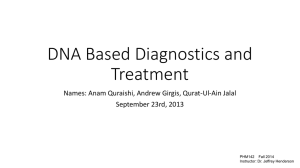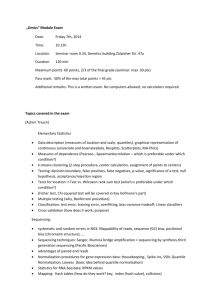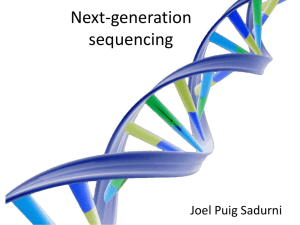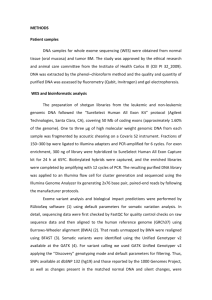Key points – Molecular Tools
advertisement
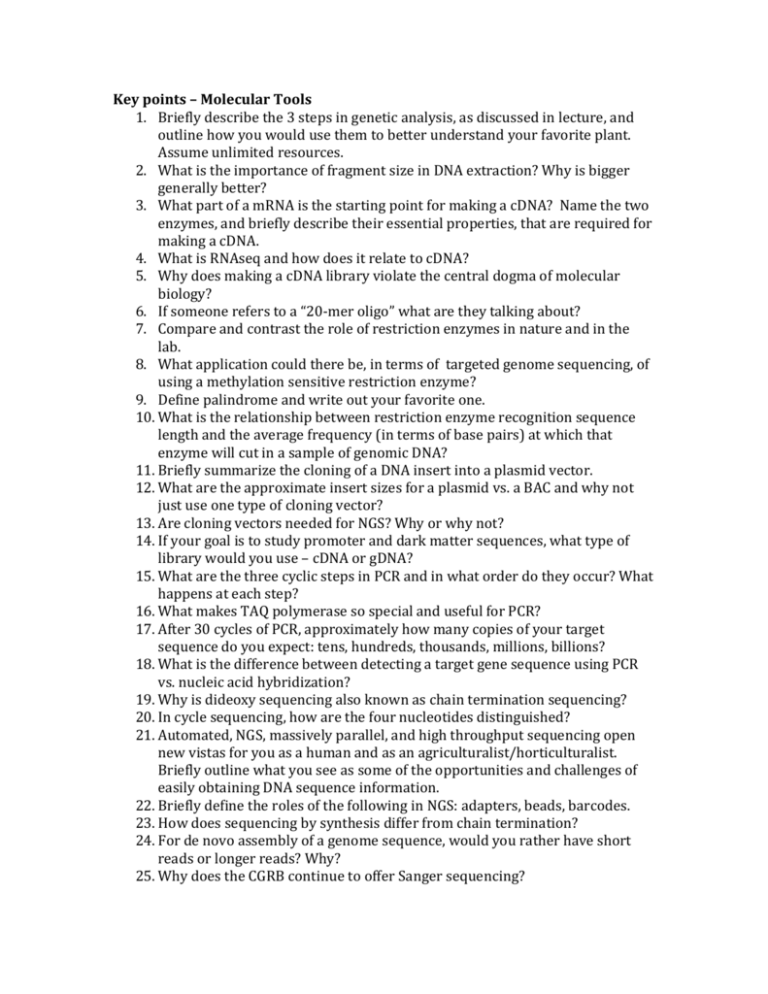
Key points – Molecular Tools 1. Briefly describe the 3 steps in genetic analysis, as discussed in lecture, and outline how you would use them to better understand your favorite plant. Assume unlimited resources. 2. What is the importance of fragment size in DNA extraction? Why is bigger generally better? 3. What part of a mRNA is the starting point for making a cDNA? Name the two enzymes, and briefly describe their essential properties, that are required for making a cDNA. 4. What is RNAseq and how does it relate to cDNA? 5. Why does making a cDNA library violate the central dogma of molecular biology? 6. If someone refers to a “20-mer oligo” what are they talking about? 7. Compare and contrast the role of restriction enzymes in nature and in the lab. 8. What application could there be, in terms of targeted genome sequencing, of using a methylation sensitive restriction enzyme? 9. Define palindrome and write out your favorite one. 10. What is the relationship between restriction enzyme recognition sequence length and the average frequency (in terms of base pairs) at which that enzyme will cut in a sample of genomic DNA? 11. Briefly summarize the cloning of a DNA insert into a plasmid vector. 12. What are the approximate insert sizes for a plasmid vs. a BAC and why not just use one type of cloning vector? 13. Are cloning vectors needed for NGS? Why or why not? 14. If your goal is to study promoter and dark matter sequences, what type of library would you use – cDNA or gDNA? 15. What are the three cyclic steps in PCR and in what order do they occur? What happens at each step? 16. What makes TAQ polymerase so special and useful for PCR? 17. After 30 cycles of PCR, approximately how many copies of your target sequence do you expect: tens, hundreds, thousands, millions, billions? 18. What is the difference between detecting a target gene sequence using PCR vs. nucleic acid hybridization? 19. Why is dideoxy sequencing also known as chain termination sequencing? 20. In cycle sequencing, how are the four nucleotides distinguished? 21. Automated, NGS, massively parallel, and high throughput sequencing open new vistas for you as a human and as an agriculturalist/horticulturalist. Briefly outline what you see as some of the opportunities and challenges of easily obtaining DNA sequence information. 22. Briefly define the roles of the following in NGS: adapters, beads, barcodes. 23. How does sequencing by synthesis differ from chain termination? 24. For de novo assembly of a genome sequence, would you rather have short reads or longer reads? Why? 25. Why does the CGRB continue to offer Sanger sequencing? 26. Given current pricing, throughput, and read length, what are the trade-offs between 454 and Illumina sequencing? From the Overview of Illumina sequencing 1. What is a contig? 2. Define genome, transcriptome, and epigenome. 3. What features are in common to Sanger Capillary Electrophoresis (CE) and next generation sequencing (NGS)? What is a key difference? 4. In terms of whole genome sequencing, in this article they use “resequencing” and “de novo sequencing” to refer to two different approaches to relating DNA sequence to chromosomes. Describe the big the difference. 5. Assuming a genome size of ~3,000 Mb how long would it take to sequence 5 different accessions and at what cost (in terms of reagents)? 6. The human genome was sequenced using CE. How long did it take and how much did it cost? Was it worth doing, or should we have waited for NGS? 7. What is an exome and what is exome sequencing? 8. What is multiplexing, and why are barcodes essential for it? 9. What does “30X coverage” mean, in terms of DNA sequencing? 10. Differentiate between constitutes a genomic library for Sanger vs. NGS sequencing. From the Qiagen PCR guide 1. What is an amplicon? 2. Why is PCR a thermodynamic and an enzymatic process? 3. Why is the standard length of a standard PCR primer 18 – 30 nt? Why not shorter? 4. What is the key role of Magnesium in PCR? Why not Sodium, Chloride, or something else? 5. What is the relationship between using a degenerate primer and the degeneracy of the DNA code? 6. How long is a “long” PCR product? 7. Why does TAQ polymerase introduce more errors during PCR than are introduced during the S phases of mitosis/meiosis? 8. What is RT-PCR and what is it used for? From the drylab biology article 1. What are public databases an essential resource for the sorts of “dry lab” analyses described in this article, and what extra challenges does this pose for “wet lab” researchers? 2. Will drylab research replace wet lab research? Which would you rather do, and why? 3. One researcher is quoted as saying that “Mendel’s peas are the exception and not the rule”. Why? 4. Ed Buckler, a maize geneticist, reports that genetic factors controlling disease resistance and flowering time were found using GWAS in non-coding DNA. What is GWAS? And how could non-coding DNA affect a phenotype? 5. A research effort is described that determined the “ancestral plant” had 7 chromosomes and 20,000 – 30,000 genes. This is referred to as a “small’ genome size? Give this number of chromosomes and this number of genes, can you be sure what size the genome was? From the woodland strawberry sequencing article 1. At what approximate level of coverage was the woodland strawberry sequenced - 10,20,30,100X? 2. The strawberry genome sequence was assembled de novo and then scaffolds were anchored to a linkage map – briefly describe what this means and why anchoring a sequence is important. 3. In the context of genome sequencing, what is a pseudomolecule?
